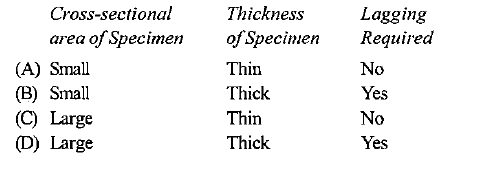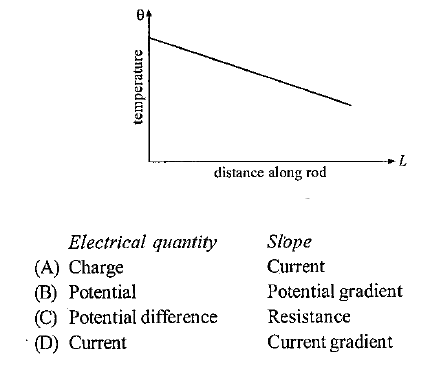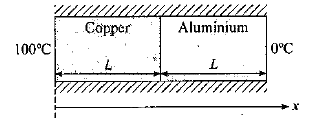Complete Solutions to Conceptual MCQs Single Option Correct of chapter HEAT TRANSFER of Class 12 book with complete answers and questions
| Class 12 | PHYSICS |
| Chapter | HEAT TRANSFER |
| PHYSICS GALAXY | Conceptual MCQs Single Option Correct |
| Number Of Questions | 24 |
| Academic Year | 2023-24 |
A bottle of water at `0^(@)C` is opened on the surface of moon. Which of the following correctly expresses the behaviour of water in it ?
07:01View SolutionThe radiation power from a source at temperature T and2m away is `2W//m^(2)`. If the temperature of the source increases by 100% the radiation power at a distance 4m from the source will increase by:
05:37View SolutionWhich one of the following statements is not true about thermal radiations ?.
04:54View SolutionA metallic sphere of diameter D has a cavity of diameter d at its centre. If the sphere is heated, the diameter of the cavity will:
02:38View SolutionThe wavelength of radiation emitted by a body depends upon
00:45View SolutionThe amount of energy radiated by a body depends upon
01:28View SolutionThe top of a lake gets frozen at a place where the surrounding air is at a temperature of `-20^(@)C` . Then :
05:29View SolutionA solid sphere and a hollow sphere of the same material and size are heated to the same temperature and allowed to cool in the same surroundings. If the temperature difference between the surroundings and each sphere is T, then :
04:04View SolutionIce starts forming on the surface of lake and takes 8 hours to form a layer of 1 cm thick. How much time will it take to increase the thickness of layer to 2 cm ?
02:20View SolutionWhy metals are good conductors of heat ?
02:19View SolutionWhy the walls and roof of the green house are made of glass ?
01:58View SolutionA drop of water is sprinkled on a red hot iron plate.The drop forms a small sphere but does not vaporise immediately. This happens because :
04:11View SolutionTwo ends of a conducting rod of varying cross-section are maintained at `200^(@)C` and `0^(@)C` respectively. There are two sections marked in the rod AB and CD of same thickness. In steady state :
 View Solution
View SolutionThemperature of a body `theta` is slightly more than the temperature of the surrounding `theta_(0)` its rate of cooling `(R )` versus temperature of body `(theta)` is plotted its shape would be .
02:25View SolutionOne end of conducting rod is maintained at temperature `50^(@)C` and at the other end ice is melting at `0^(@)C`. The rate of melting of ice is doubled if:
04:10View SolutionThe diagram below shows rods of the same size of two different materials P and Q placed end to end in thermal contact and heavily lagged at their sides. The outer ends of P and Q are kept at `0^(@)C` and `100^(@)C`,respectively.The thermal conductivity of P is four times that of Q. What is the steady-state temperature of the interface?
 View Solution
View SolutionThe length of the two rods made up of the same metal and having the same area of cross-section are 0.6 m and 0.8 m respectively. The temperature between the ends of first rod is `90^(@)` C and `60^(@)` C and that for the other rod is 150 and `110^(@)` C. For which rod the rate of conduction will be greater
03:02View SolutionWhy two thin blankets put together are warmer than one blanket of double the thickness ?
01:44View Solution`lambda_(m)` is the wavelength of the radiations corresponding to maximum intensity of a very very hot body at temperature T. Which of the following correctly represents the relations between `lambda_(m)` and T:
03:01View SolutionIn designing a method for measuring the thermal conductivity of polystyrene, care must be taken to choose a specimen of appropriate dimensions as well as to decide whether or not the specimen requires lagging. Which ofthe following would be the correct choice ?
 03:02View Solution
03:02View SolutionThe graph shows how temperature varies with distance along a well-insulated metal rod which is conducting thermal energy at a steady rate. The slope of this graph is the temperature gradient. There is an analogy between electrical conduction and thermal energy conduction. If an equivalent electrical-graph were to be drawn, which electrical quantity,when plotted against distance along the rod, would have the slope shown. ?
 03:02View Solution
03:02View SolutionA composite rod of uniform cross-section has copper and aluminium sections of the same length in good thermal contact. The ends of the rod, which is well-lagged, are maintained at `100^(@)C` and at` 0^(@)C` as shown in the diagram (Figure-4.33). The thermal conductivityof copper is twice that of aluminium.
Which one of the following graphs represents the variation of temperature T with x along the rod in the steady state ?
 02:24View Solution
02:24View SolutionPQ is a fully-lagged metal bar, containing a section XY of a material of lower thermal conductivity. The thermal conductivities of the two materials are independent of temperature. Ends P and Q are maintained at different temperature.
In the steady , the temperature difference across XY would be independent of :
 03:49View Solution
03:49View SolutionTwo adiabatic vessels, each containing the same mass m of water but at different temperatures, are connected by a rod of length L, cross-section A, and thermal conductivity K. the ends of the rod are inserted into the vessels, while the rest of the rod is insulated so that .there is negligible loss of heat into the atmosphere. The specific heat capacity of water is s, while that of the rod is negligible. The temperature difference between the two vessels reduces to `l//e` of its original value after a time, `delta t`. The thermal conductivity (K) of the rod may be expressed by:
08:14View Solution
Conceptual MCQs Single Option Correct questions and complete solutions for chapter HEAT TRANSFER of GK PUBLICATIONS PHYSICS (HINGLISH) of Class 12
All Exercises from PHYSICS GALAXY Class 12 PHYSICS HEAT TRANSFER
- Advance MCQs with One or More Option Correct
- Conceptual MCQs Single Option Correct
- Discussion Question
- Illustrative Example 4.1
- Illustrative Example 4.10
- Illustrative Example 4.11
- Illustrative Example 4.12
- Illustrative Example 4.13
- Illustrative Example 4.14
- Illustrative Example 4.15
- Illustrative Example 4.16
- Illustrative Example 4.17
- Illustrative Example 4.18
- Illustrative Example 4.19
- Illustrative Example 4.2
- Illustrative Example 4.20
- Illustrative Example 4.21
- Illustrative Example 4.22
- Illustrative Example 4.23
- Illustrative Example 4.24
- Illustrative Example 4.25
- Illustrative Example 4.26
- Illustrative Example 4.27
- Illustrative Example 4.28
- Illustrative Example 4.29
- Illustrative Example 4.3
- Illustrative Example 4.4
- Illustrative Example 4.5
- Illustrative Example 4.6
- Illustrative Example 4.7
- Illustrative Example 4.8
- Illustrative Example 4.9
- Numerical MCQs Single Options Correct
- Practice Exercise 4.1
- Practice Exercise 4.2
- Practice Exercise 4.3
- Practice Exercise 4.4
- Unsolved Numerical Problems for Preparation of NSEP,INPhO&IPhO
